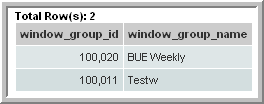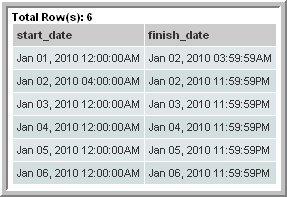Storage Viewer for Backup Functions
APTgetJobTypeName
This function can be used to query database tables related to backup job details, such as apt_v_job and apt_v_nbu_job.
FUNCTION APTgetJobTypeName(
productType,
jobType,
vendorJobType)
This function returns a character string. Note that in the SQL Template Designer query, the function name must be prefaced with: rtd.
Argument Name | Type | Length |
productType | Number | 2 |
jobType | Number | 4 |
vendorJobType | Number | |
Example Query 1
SELECT rtd.APTgetJobTypeName(j.product_type, j.job_type, NULL) FROM apt_v_job j
Example Query 2
SELECT rtd.APTgetJobTypeName(j.product_type, j.job_type, n.vendor_job_type)
FROM apt_v_nbu_job n, apt_v_Job j
WHERE j.job_id = n.job_id
The output from this example:
Full Backup
Appl Backup
Appl Backup
APTgetTapeDriveStatusName
Use this function to access data from:
apt_v_tape_drive
This function returns a character string. Note that in the SQL Template Designer query, the function name must be prefaced with: rtd.
FUNCTION APTgetTapeDriveStatusName(
vendorProductType,
vendorDriveStatus)
Argument Name | Type | Length |
vendorProductType | Number | |
vendorDriveStatus | Character | 1 |
Example Query
SELECT rtd.APTgetTapeDriveStatusName(d.product_type, d.vendor_drive_status) FROM apt_v_tape_drive d
The output from this example:
Up
In-Use
In-Use
Mounting
getFullPathname
Use this function to access data from:
apt_v_client_file
This function returns a character string. Note that in the SQL Template Designer query, the function name must be prefaced with: rtd.
FUNCTION getFullPathname(
clientID,
clientFileID)
Argument Name | Type | Length |
clientID | Number | 6 |
clientFileID | Number | 10 |
Example Query
SELECT rtd.getFullPathname(d.client_id, d.client_file_id) FROM apt_v_client_file d
listJobSummaryAfterRestart
This function returns a list of NetBackup jobs. It could be used, for example, to determine ultimate success for NetBackup jobs within a backup window. For example, if the backup window was set for 4:00 p.m. to 4:00 p.m. the next day, if the restart completed before the end of the backup window, it is considered to be successful.
Note that in the SQL Template Designer query, the function name must be prefaced with: rtd.
listJobSummaryAfterRestart(
startDate,
finishDate,
backupWindowId,
clientList,
excludeStatusList,
excludePolicyList,
excludeClientList)
Argument Name | Type |
startDate | DATE with the value derived from the Scope Selector |
finishDate | DATE with the value derived from the Scope Selector |
backupWindowId | Numeric |
clientList | numberListType Example: numberListType(1,2,3) |
excludeStatusList | numberListType Example: numberListType(1,2,3) |
excludePolicyList | numberObjectListType Example: numberObjectListType(numberObjectType(1), numberObjectType(2)) |
excludeClientList | numberObjectListType Example: numberObjectListType(numberObjectType(1), numberObjectType(2))) |
listJobSummaryAfterRestartNBW
This function returns a list of NetBackup jobs that do not have a backup window. It could be used, for example, to determine ultimate success for NetBackup jobs. If the job restart finishes within the timeframe (startDate - finishDate), it is considered successful.
Note that in the SQL Template Designer query, the function name must be prefaced with: rtd.
listJobSummaryAfterRestartNBW
startDate,
finishDate,
clientList,
excludeStatusList,
excludePolicyList,
excludeClientList,
jobTypeList)
Argument Name | Type |
startDate | DATE with the value derived from the Scope Selector |
finishDate | DATE with the value derived from the Scope Selector |
clientList | numberListType Example: numberListType(1,2,3) |
excludeStatusList | numberListType Example: numberListType(1,2,3) |
excludePolicyList | numberObjectListType Example: numberObjectListType(numberObjectType(1), numberObjectType(2)) |
excludeClientList | numberObjectListType Example: numberObjectListType(numberObjectType(1), numberObjectType(2))) |
jobTypeList | numberListType Example: numberListType(1,2,3) |
listJobSummaryAfterRestart for NetWorker Backup Jobs
This function returns a list of NetWorker jobs within a backup window. It could be used, for example, to determine ultimate client backup success for EMC NetWorker jobs. If the job restart finishes within the time frame (startDate - finishDate), it is considered successful.
In a SQL Template Designer query, the function name must be prefaced with: leg_rtd.
listJobSummaryAfterRestart(
startDate,
finishDate,
backupWindowId,
clientList,
excludeStatusList,
excludePolicyList,
excludeClientList)
Argument Name | Type |
startDate | DATE with the value derived from the Scope Selector |
finishDate | DATE with the value derived from the Scope Selector |
backupWindowId | If no backup window is defined, the default is 12 hours from the start date. • To configure a Backup Window via the Portal: Admin > Backup Windows > Add |
clientList | numberListType Example: numberListType(1,2,3) |
excludeStatusList | numberListType Example: numberListType(1,2,3) |
excludePolicyList | numberObjectListType Example: numberObjectListType(numberObjectType(1), numberObjectType(2)) |
excludeClientList | numberObjectListType Example: numberObjectListType(numberObjectType(1), numberObjectType(2))) |
Example Query
NOTE: In the following sample Report Template query, spHosts is the same as Hosts, but is specifically for use in stored procedures.
SELECT job_id, c.hostname client, s.hostname server, sc.schedule_name, start_date, finish_date, kilobytes, DECODE(overall_status,0, 'Successful',1,'Partial',3,'Running',4,'Failed', NULL) overall_status,
DECODE(was_restarted,0,'No','Yes') was_restarted, vendor_status, orig_vendor_status, client_resource_name, window_start_date, window_finish_date
FROM TABLE(leg_rtd.listJobSummaryAfterRestart(${startDate},${endDate},100000,${spHosts},
null,null,null)) t, apt_v_server s, apt_v_server c, apt_v_leg_schedule sc
WHERE t.server_id = s.server_id
AND t.client_id = c.server_id
AND t.schedule_id = sc.schedule_id(+) ORDER BY t.start_date
listOfBackupWindowDates
Two versions of this function enable the following functionality:
• returns a list of backup windows explicitly supplied in the function
Note that in the SQL Template Designer query, the function name must be prefaced with: rtd.
Explicitly Supply the Backup Windows
FUNCTION listOfBackupWindowDates(
startDate,
finishDate,
backupWindowList IN apt_BackupWindowListType)
Argument Name | Type |
startDate | Date |
finishDate | Date |
backupWindowList | |
Based on the backup window definition, the above function returns a list of the adjusted start and finish dates.
Example Query
SELECT start_date, finish_date
FROM TABLE(rtd.LISTOFBACKUPWINDOWDATES(TO_DATE('01012008','MMDDYYYY'), to_DATE('01072008','MMDDYYYY'),
apt_BackupWindowListType(
APT_BACKUPWINDOWTYPE('Mon', 40, 64),
APT_BACKUPWINDOWTYPE('Tue', 64, 88),
APT_BACKUPWINDOWTYPE('Wed', 88, 112),
APT_BACKUPWINDOWTYPE('Thu', 112, 136),
APT_BACKUPWINDOWTYPE('Fri', 136, 160),
APT_BACKUPWINDOWTYPE('Sat', 160, 184),
APT_BACKUPWINDOWTYPE('Sun', 16, 40)
)
))
The output from this example:
12/31/2007 4:00:00 PM 1/1/2008 3:59:59 PM
1/1/2008 4:00:00 PM 1/2/2008 3:59:59 PM
1/2/2008 4:00:00 PM 1/3/2008 3:59:59 PM
1/3/2008 4:00:00 PM 1/4/2008 3:59:59 PM
1/4/2008 4:00:00 PM 1/5/2008 3:59:59 PM
1/5/2008 4:00:00 PM 1/6/2008 3:59:59 PM
1/6/2008 4:00:00 PM 1/7/2008 3:59:59 PM
listOfBackupWindowDates (by Backup Window ID)
Retrieve Backup Windows (Defined in the Portal) with a Backup Window ID
FUNCTION listOfBackupWindowDates(
startDate,
finishDate,
windowGroupID IN apt_date_window.windows_group_id%TYPE)
Argument Name | Type |
startDate | Date |
finishDate | Date |
windowGroupID | |
Based on the backup window definition, the above function returns a list of the adjusted start and finish dates.
Example Query
The following examples provide a basic idea of the function. These queries should serve as only an example of how the function might be incorporated into a more sophisticated query.
In a SQL Template Designer query, first determine the Backup Window IDs:
select window_group_id, window_group_name from apt_v_date_window
Then, use the Backup Window ID (window_group_id value from above example) in the following query:
select * from TABLE(rtd.listOfBackupWindowDates(TO_DATE('01012010','MMDDYYYY'), to_DATE('01072010','MMDDYYYY'), 100011 ))


